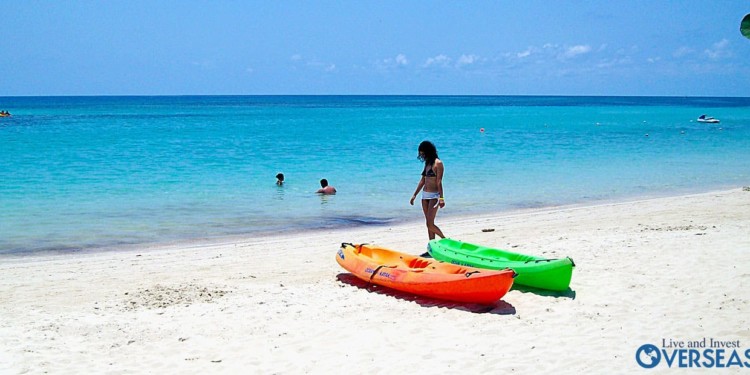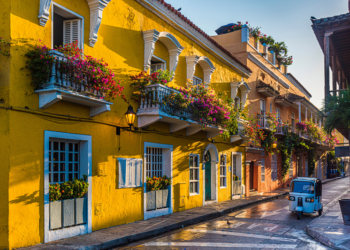Untamed Paradise In The Caribbean
If you were a backpacking scuba diver in the 1960s, you may have drifted through the Bay Islands of Honduras on a quest for Caribbean adventure. Many fitting that description did. Offshore from Roatán, in particular, the largest of the Bay Islands, was (and is still today) some of the best diving in the world.
The island itself back then was an off-the-radar and wholly undeveloped, untamed outpost where cows and pigs grazed freely and bananas grew everywhere.
About 20 years ago, small hotels and resorts began to appear on Roatán to accommodate the increasing number of scuba divers. As visitors discovered this idyllic part of the Caribbean no one had ever heard of, they started to buy land and build homes. This was the beginning of an expat community that, over the two decades since, has grown to become one of the biggest and most established in the world.
That is not to say that Roatán today is developed in the way you might imagine. Today, flying in you’ll see an island that is about 40 miles long and 5 miles across at its widest point… and vibrantly green.
There are no high-rise hotels, because building regulations don’t allow for them. Density restrictions within the beach zones have contained development… in a good way. Cows and pigs still graze this lush, green island. Bananas and coconuts still grow wild.
Despite the dramatic growth in its expat population, Roatán remains an untamed paradise—a Shangri-la for nature lovers.
Honduras, with the help of its Ministry of Tourism, became the first country to adopt the concept of “geotourism” as its tourist agenda, going a step further than the popular “ecotourism” and meaning to suggest a very natural experience.
This has its pluses and its minuses. Roatán is long on Caribbean charm and Caribbean beaches but short on infrastructure. Cows and pigs not only graze the lush grassy interior but also wander occasionally along the pot-holed and dirt roads.
On the other hand, the still raw experience that is Roatán means nothing is interfering with the extraordinary natural beauty of this place, its white-sand beaches, its crystal-clear water, or its abundant wildlife, both on land and underwater.
Change comes slowly on Roatán; only if you visited years ago will you appreciate the infrastructure and amenity improvements that have taken place.
The small town of West End is the island’s hub. The town is quaint, quirky, and lots of fun, with dive shops, gift shops, hotels, restaurants, bars, and even an art gallery. This is the place to come for both amenities and services. In West End you can swim, snorkel, and parasail (jet skis are still frowned upon on Roatán), attend a baseball game, enjoy a massage or yoga… or simply lie back and soak up this tropical paradise.
As a retiree on Roatán, it’s also West End where you’d go to get a lock fixed, to contact a builder, to have your dive gear serviced and repaired, to arrange tours, or to rent a car or scooter.
The eastern end of Roatán is steeped in pirate folklore. The inlets, or bights, provided safe harbor for the likes of Blackbeard, William Walker, and Henry Morgan, and treasure hunters still dive these waters. Much less developed than West End, the east end of Roatán boasts stunning views of both sides of the island from the road that follows the spine of the mountain range. The Bay Islands are the top of underwater mountains formed when two tectonic plates collided about 50 million years ago.
Much of the dramatic eastern end of the island is accessible only by boat. As a result, this part of the island is better suited to the more self-sufficient adventurer. The payoff for a less convenient lifestyle is peace, tranquility, and uncommon natural beauty. The east end is home to flocks of parrots, small island deer, iguanas, and a variety of life not usually seen on the western end.
The settlement towns of Oak Ridge, Jonesville, and Port Royal on the southeast side of the island are where you’ll find some of the island’s most established families. Life passes slowly among the elders, who are skilled storytellers and love to entertain anyone who stops to ask about the pirate-rich history of this place.
English is the language of the Bay Islands; Spanish is the official language of Honduras. Increased tourism and development have meant a growing labor demand. Hondurans from the mainland have been moving to Roatán in recent years to take advantage of the opportunity for work, meaning you hear more Spanish on the island today than even a few years ago. Still, the retiree settled here would not have to worry about learning a new language.
Roatán’s climate is tropical, with little change in temperature from winter to summer but with variation in rainfall between the wet and dry seasons. The main wet season is mid-October through December or mid-January. However, weather patterns change frequently on the island; a day during the wet season can be sunny with only slight rain or can have continual rainfall. Humidity is highest May through September, though the steady easterly trade winds help.
The still largely undiscovered Bay Island of Roatán is an ideal retirement choice for anyone who loves the Caribbean Sea and a lifestyle that revolves around it. The way of life could perhaps best be described as back-to-basics, but the island also offers more upscale living options, as well, including full-security, full-amenity gated communities and a world-class golf community. Prices in these communities reflect the standard you’re buying into. A luxury home overlooking the golf course can cost more than a million dollars.
On the other hand, you could purchase a one-bedroom town home on the golf course or with a sea view for US$360,000.
Janine Goben
Overseas Living Letter Contributor

















